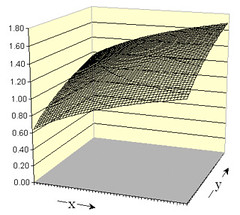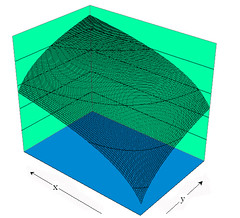Utility Functions Close Up
A basic staple of microeconomics is the utility function, which is usually presented to students thus:
Let U represent consumer utility as a function of goods x and y. Maximize U(x,y) subject to I = p1x + p2y. U(x,y) = ln(xy).
Sometimes the textbook writer tries something fancy, like U(x,y) = α ln(x) + β ln(y), where α and β are exponents of any value.
The Lagrangian for this equation is
L(λ,x,y) = α ln(x) + β ln(y) + λ(I — p1x — p2y) And the first order conditions are
= α/x — λp1 = 0
= β/y — λp2 = 0
= I — p1x — p2y = 0
These simplify to x* =and y* =
, which means that expenditure on either x or y would always be exactly the same given a constant income; the actual amount consumed would vary inversely with price.
Map of Cobb-Douglas Utility function Click for larger image |
Linear Expenditure Utility function Click for larger image |
An alternative to the Cobb-Douglas Utility function is the linear expenditure function. This modifies the utility function to
where x0 and y0 are given constants, and α + β = 1.
In this case, the optimal values of x*, y* are
p1x = αI + βp1x0 — αp2y0
p2y = βI — βp1x0 + αp2y0
which can be contrived to alter the shape of indifference curves; say, if we wanted to discuss fuel versus everything else, and then changed the subject to another type of good that is a superior good.



0 Comments:
Post a Comment
<< Home